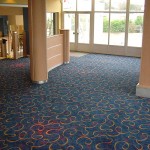Green Home Improvement: Making a Rain Barrel

Materials:
Large barrel, hose adaptor, 6″ screen, and faucet or specially designed rain barrel
Downspot parts
Rain
Hose
Preparation:
If you purchase a rain barrel, you can skip ahead to the “installation” section.
Clean the barrel. Do not use bleach as it can damage the environment. Vinegar is an excellent option.
Cut out a whole on the top of your barrel to match your screen size. Attach the screen.
To create an overflow and prevent erosion, drill a hole a few inches from the top of the barrel. Screw in the hose adapter here. When the rain barrel gets too full, water will run out the hose.
Drill a hole near the bottom of the barrel (about 6-10″ from the ground) and attach the faucet (make sure to prepare it using plumber’s tape)
Installation:
Select a spot for your rain barrel near an existing downspout.
Plan how you want to re-route the downspout to pour into the barrel.
Purchase the correct parts – make sure to measure your existing downspout so you get the right size.
Slide new downspout parts onto the existing downspout.
Put the rain barrel so it catches water.
Attach a hose to the bottom of the downspout, or leave it free to use to fill up watering cans.
Benefits:
Save water by using what comes from the sky instead of your faucet.
Depending on placement, may be a more convenient way to keep compost piles or gardens moist.
Cautions:
Using a screen prevents leaves and other debris from getting in the water and clogging the faucets.
Be sure to use the water periodically so it isn’t stagnant.
Do not use the water collected for drinking, bathing, or cooking.
Keep the lid secure to prevent accidental drowning.
Elevate the rain barrel using cinder blocks to make it easier to use the faucet while still keeping the faucet near the ground.
Remove the barrel during the winter to avoid overflow from snow melt that occurs. Re-attach in early spring to take advantage of late melting snow and early rains.



